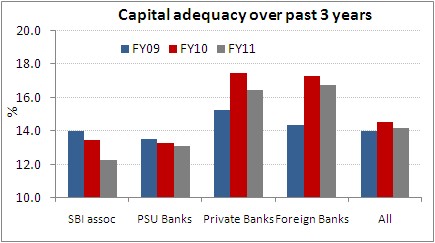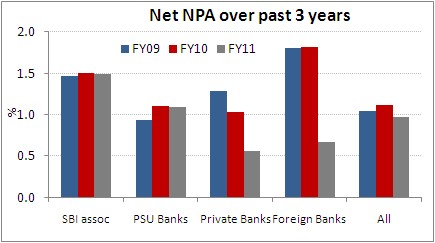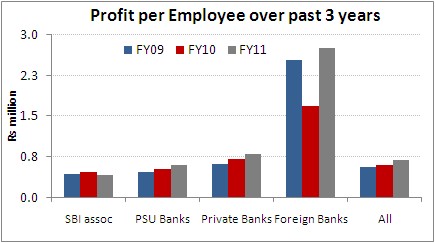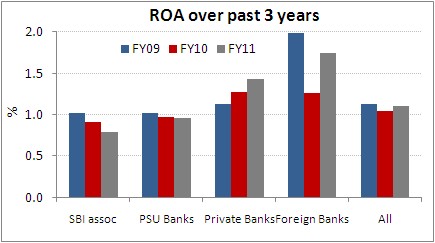The Reserve Bank of India (RBI) recently came out with draft guidelines for the entry of new private sector banks into the sector. Most major corporate houses in India including the Tatas, Ambanis, Mahindras, Birlas, Bajaj Group etc are all ready to jump on the bandwagon. They are all seeking to apply for new banking licenses. Even various non-banking finance companies including Religare, Shriram Group etc are also in the fray. The beleaguered SKS Microfinance is also said to looking for a license, in order to improve its ailing fortunes.
Why is everyone so eager to be a part of this industry? We thought it would be interesting to see how the banking sector has progressed over the past three years. We wanted to find out what exactly is the current scenario. To see this we concentrated on the bank's profitability, capital requirements as well as their asset quality. To understand the same; we analyzed a few ratios from the perspective of the various banking groups in India. In this article, we focused mainly on private sector banks, foreign banks, public sector banks and SBI and its associates.
Capital adequacy ratio: A bank's capital adequacy ratio (CAR) is the ratio of qualifying capital to risk adjusted (or weighted) assets. The RBI has set the minimum capital adequacy ratio at 9% for all banks. A ratio below the minimum indicates that the bank is not adequately capitalized to expand its operations. The ratio ensures that the bank do not expand their business without having adequate capital against their assets.
It can be seen that most banks are well above the minimum capital adequacy ratio set by the RBI. However the same saw a decline across the board in FY11. Private sector banks and foreign banks however maintain higher capital ratios, giving them a significant capital cushion. Public sector banks, especially State Bank of India needs to soon bolster its capital position. Its Tier-1 capital ratio has currently sunk below 8%, the minimum desired level by the government.
 |
|
|
Non-performing asset (NPA) ratio: The net NPA to loans (advances) ratio is used as a measure of the overall quality of the bank's loan book. NPA or non performing assets are those loans for which interest is overdue for more than 3 months. Net NPAs are calculated by reducing cumulative balance of provisions outstanding at a period end from gross NPAs. A higher ratio reflects rising bad quality of loans.
On an overall basis net NPAs declined in FY11. While private banks and foreign banks were able to contain their NPAs, public sector banks and SBI could not improve their asset quality. Going forward, we believe that asset quality will continue to be under some pressure. This is on account of the central bank's monetary tightening and the slowdown in the economy. Plus, public sector banks may also face the heat on account of shifting all their smaller accounts to the core banking system. This will help in more accurate recognition of NPAs on a timely basis. However, NPAs are expected to see a spike on this account.
 |
|
|
Profit per employee: Profit per employee measures the productivity of a bank's employees. This ratio is calculated by dividing the total profits of the group by the number of employees. A higher ratio indicates that the bank is able to generate more profits through its employees. This partly has to do with the business mix, as can be seen with the foreign banks, which rank much higher in profits per employees on account of their focus on higher margin products. These foreign banks also don't have much branch presence in the country. Cumulatively the 33 foreign banks, have just 316 offices in India. Public sector banks on the other hand have over 60,000 offices, and over 750,000 employees across 26 banks. Among the private sector banks, Yes Bank and Axis Bank rank quite highly in this ratio.
Profit per employee across the bank groups increased during FY11, except for State Bank of India and its associates. SBI's FY11 profits were severely dampened on account of increased provisioning as well as pension related expenses.
 |
|
|
Return on assets (ROA) ratio: ROA is a commonly used figure used to comparing performance of financial institutions and banks. The ROA ratio is the net income (profits) generated by the bank on its total assets (including fixed assets). The higher the proportion of average earnings assets, the better would be the resulting returns on total assets.
At bank group level, most bank groups witnessed an increase in return on assets in FY11, with the exception of SBI and its associates, which witnessed decline in return on assets.
 |
|
|
In conclusion
Most banks have seen a steady progression over the past few years. This is either in terms of improvement in asset quality or higher profitability. With the exception of SBI and its associates, most banks were able to better their FY10 performance in FY11. However, things may not look so rosy in FY12, as the full impact of the central bank's monetary tightening, and the economic slowdown takes its toll. Either way, with a large portion of this country still unbanked, there is still a lot of scope for the development of the industry in this country, which we hope the new ‘private sector banks' will be able to cater to.







 CAclubindia
CAclubindia
